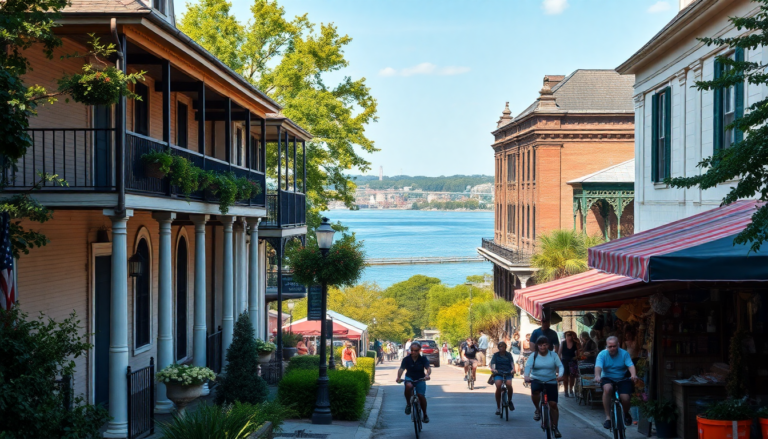Argomenti trattati
- The Capitol Park Museum: A gateway to Louisiana’s story
- Louisiana Art & Science Museum: Where culture meets curiosity
- The Old State Capitol: A gothic masterpiece
- The Louisiana State Capitol: A towering symbol of history
- Burden Museum & Gardens: A glimpse into rural Louisiana
- Magnolia Mound: A slice of Creole history
- USS Kidd: A floating piece of history
- Bluebonnet Swamp Nature Center: Nature’s retreat
When you think of Louisiana, New Orleans often steals the spotlight, but what if I told you that Baton Rouge, the state capital, is a treasure trove of history, culture, and hidden gems just waiting to be discovered? Tucked away along the mighty Mississippi River, this charming city invites you to step back in time and immerse yourself in the vibrant Creole and Cajun heritage that permeates its streets. The allure of Baton Rouge lies not just in its storied past, but in its ability to captivate visitors with its authenticity and warmth.
The Capitol Park Museum: A gateway to Louisiana’s story
Located in the heart of Baton Rouge, the Capitol Park Museum serves as a narrative hub, chronicling the state’s cultural, social, and economic evolution. With an assortment of artifacts, interactive displays, and poignant testimonials, the museum invites exploration. One particularly striking exhibit features a 15-meter-long shrimp boat, alongside a rare Civil War submarine, and an impressive collection of local musical heritage, including pieces like Louis Armstrong’s trumpet and Buddy Guy’s iconic polka-dotted Stratocaster guitar. The museum doesn’t shy away from the challenging aspects of Louisiana’s history. A dedicated section highlights the African American struggle for civil rights, documenting the grim realities of slavery and segregation, including the Baton Rouge bus boycott of 1953, a pivotal moment that resonated throughout the South.
Louisiana Art & Science Museum: Where culture meets curiosity
Set in a repurposed railroad depot along the river, the Louisiana Art & Science Museum (LASM) is a beacon of creativity and education. Its star attraction? A fascinating Ancient Egyptian exhibit housing an authentic Ptolemaic mummy in a meticulously recreated tomb. Engaging galleries of art and science capture the imaginations of young and old alike, offering hands-on experiences that inspire curiosity. The Irene W. Pennington Planetarium, with its 18-meter dome, hosts spectacular astronomical shows and immersive films, allowing visitors to journey through the cosmos without leaving the ground.
The Old State Capitol: A gothic masterpiece
Perched majestically along the Mississippi, the Louisiana’s Old State Capitol is a historical marvel. Built in 1850 in a gothic revival style, this “castle on the river” once housed the state legislature and is now home to the Louisiana Museum of Political History. Declared a National Historic Landmark, it has seen its share of drama, from hosting the secession convention in 1861 to surviving fires and renovations. Visitors can admire the stunning cast-iron staircase and stained glass dome, remnants of an era gone by.
The Louisiana State Capitol: A towering symbol of history
Standing tall at 137 meters, the Louisiana State Capitol in Baton Rouge is the tallest state capitol building in the United States. Erected under the direction of the charismatic Governor Huey P. Long, this Art Deco skyscraper, completed in 1932, is more than just an architectural feat. It’s a landmark of Louisiana’s political history, featuring exhibitions that explore the state’s governance. Ascending to the observation deck on the 27th floor rewards visitors with breathtaking views of Baton Rouge and the winding Mississippi.
Burden Museum & Gardens: A glimpse into rural Louisiana
Just minutes from downtown Baton Rouge, the Burden Museum & Gardens showcases the rich tapestry of Louisiana’s rural history. Nestled on Essen Lane near Interstate 10, this 6-acre site includes the Rural Life Museum, which boasts the largest collection of vernacular architecture in Louisiana. Wander through exhibits filled with artifacts from the 18th to early 20th centuries, and explore the expansive Botanical Gardens, which feature thematic spaces, woodlands, and wetlands. The Trees and Trails pathway offers over 5 kilometers of peaceful exploration through nature, while the romantic Windrush Gardens, inspired by historic Louisiana homes, provide a serene escape under the shade of ancient oak trees.
Magnolia Mound: A slice of Creole history
Stepping into Magnolia Mound is like traveling back to the late 18th century. This beautifully restored Creole plantation house, built in 1792, offers an authentic glimpse into rural Louisiana life in the early 1800s. Each room is a snapshot of history, meticulously recreated with period furniture and artifacts. The property also features several historic structures, including an open-hearth kitchen and the workers’ quarters, allowing visitors to appreciate the complexities of plantation life.
USS Kidd: A floating piece of history
Docked along the river, the USS KIDD (DD-661) stands as a testament to naval history. This restored Fletcher-class destroyer, known as the “Pirate of the Pacific,” offers a unique museum experience, inviting visitors to explore its decks and command rooms across five levels. Adjacent to the ship, the Veterans Museum showcases an impressive array of military artifacts, from a P-40 Warhawk fighter plane to a replica of a World War I trench, honoring the bravery of Louisiana’s veterans.
Bluebonnet Swamp Nature Center: Nature’s retreat
On the outskirts of Baton Rouge, the Bluebonnet Swamp Nature Center is a haven for environmental education and conservation. With its focus on sustainability, the center features engaging exhibits about local flora and fauna, along with collections of natural artifacts. Outdoor pathways and elevated boardwalks wind through diverse habitats typical of the southern United States, from cypress swamps to hardwood forests, offering visitors the chance to observe local wildlife in their natural settings.

